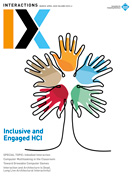Authors:
Marion Lean
Inbodied interaction focuses on connecting knowledge of how the processes inside our bodies (and around our bodies) affect our everyday performance. An opportunity for design is to explore how we can embody these inbodied processes, making them tangible to help people make sense of, and make choices about, how they tune in these inbodied processes. What follows is one inbodied interaction design proposal.

The following prototype, using fat types as an example, draws on a material perception of nutrition to connect with interpretations of the physical impact of food choice on our bodies.
Fat, like most inbodied interaction topics, is complex. There are numerous types of fat and roles for fat in our bodies. Different kinds of fats wrap every cell of our body. The stiffness or responsiveness of those cells is based on the types of foods (including the types of fats) we eat. The brain is mostly fat, and requires certain essential fats like DHA (found in omega 3s from sources like fish, algae, and walnuts). Different fat types help build hormones and vitamins, and provide insulation for nervous tissue and the brain. And, of course, fats are also fuels, both providing energy (white fat) and creating heat (brown fat). There is no good or bad fat, only ratios. For instance, cholesterol is part of every cell membrane, and is critical for moving different types of fats through the bloodstream and synthesizing hormones. Types of foods we eat with their different kinds of poly-, mono-, and unsaturated fats, for example, also influence our internal ratios of fats and thus contribute to our overall health. Fats are complex; they are amazing. They are also awfully abstract.
We suggest that making tangible ideas around imbalances in fat types can contribute to an understanding of strategies for food intake. Rather than focus on the supposed negative impacts of certain fats, the design aim is to express the benefits of maintaining ratios to create balance patterns (see balanced/ratioed in the introductory article). The use of balance as patterns is extended to a physical design space intended to support an understanding that what we eat performs particular functions around the body (energize, protect, repair); however, an imbalance can lead to problems.
 Embodied-Inbodied Design Experience
Embodied-Inbodied Design Experience
The objective is to draw on connections between physical structure and materials, both of the food we eat and the internal, inbodied systems supporting our own growth, repair, and rhythms to create a tangible information experience [1]. The functioning of fats in the body is complex. Engaging embodied methods, adapted from textile and somaesthetic design [2], combined with inbodied interaction enables a deeper understanding of both different fats and their roles, and ideas for representing them within aspects of inbodied lenses.
Depending on the food choices, a tapestry of fat/food choice is generated. The material experience [3] represents a balanced, unbalanced, or varied diet and how these relationships work. Manipulating materials' behavior (the diet) would alter the structural outcome and installation experience.
 The Design Concept: Fat Tapestry
The Design Concept: Fat Tapestry
Physiologically, the focus of the work is on the balancing of fats, respecting the complex makeup and melange of what we ingest in relation to what goes on inside.
Drawing on textile thinking to consider fats as fibers in a large-scale interactive installation, warp threads on a loom-like structure overhead represent the body (Figure 1). A light shines through the loom, creating a projected pattern below. A dynamic range of materials form weft threads, continually weaving in and out. The materials used represent varied types of fats. To communicate ideas around excess/imbalance, the materials either work with or against each other, creating different woven patterns. Even, strong forms represent a balanced fat intake, supporting inbodied structure. With imbalance, the pattern disrupts. Bulges and buildups in particular parts of the "cloth" will obscure light patterns from shining through, evoking inflammation, clogged arteries, stiff veins.
Physically, the cloth would constantly be changing, moving, adapting—sometimes opaque, sometimes transparent, depending on the inbodied fat state.
Drawing on everyday familiarity with materials, the proposed palette contains a range of types of threads that individually would not be structurally sound but that collectively enable strong performance. Installation visitors can "feed" the structure, letting people explore/make sense of some key fat roles and ratios. Capturing how participants reinterpret their own bodies and diets from this installation would also become part of the experience.
1. Shaer, O. and Hornecker, E. Tangible user interfaces: Past, present, and future directions. Found. Trends Hum.-Comput. Interact. 3, 1–2 (2010), 1–137.
2. Hook, K. Designing with the Body. MIT Press, 2018.
3. Karana, E., Pedgley, O., and Rognoli, V. On materials experience. Design Issues 31, 3 (2015), 16–27.
Marion H. A. Lean is a practice-based researcher in design research (textiles) at the Royal College of Art. Her Ph.D. thesis, "Materialising Data Experience through Textile Thinking" (2019), explored methods for implementing material practices as design research tools in the area of emerging technology and data experience. [email protected]
©2020 ACM 1072-5520/20/03 $15.00
Permission to make digital or hard copies of all or part of this work for personal or classroom use is granted without fee provided that copies are not made or distributed for profit or commercial advantage and that copies bear this notice and the full citation on the first page. To copy otherwise, to republish, to post on servers or to redistribute to lists, requires prior specific permission and/or a fee.
The Digital Library is published by the Association for Computing Machinery. Copyright © 2020 ACM, Inc.








Post Comment
No Comments Found